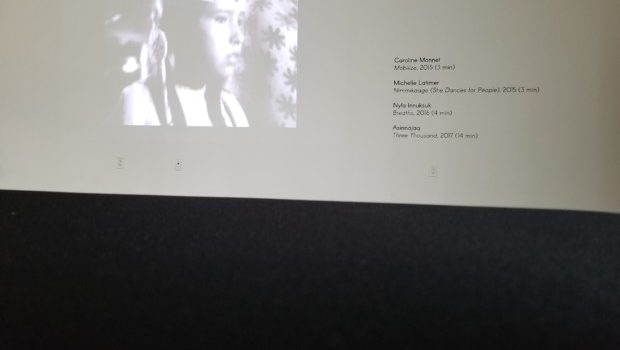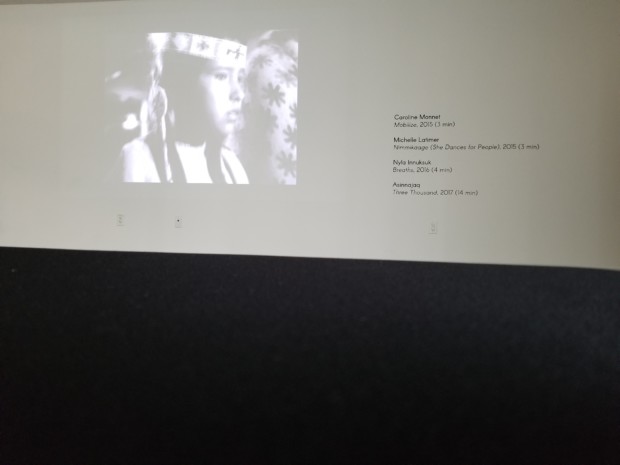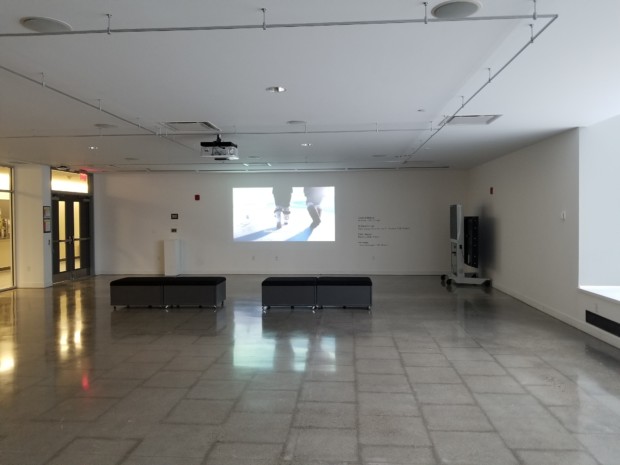

Short films bring long-term messages to Lakeshore gallery
EntertainmentLifestyleVisual arts Jan 15, 2019 Clement Goh

Short film anthology connects to discuss indigenous culture.
An empty gallery in Lakeshore’s L-Space echoes with vocals. A projector flashes images of snow, lighting up the dim environment. For more than 20 minutes, a series of short films show life in a different place away from our urban habitat.
Scenes of wildlife are balanced with indigenous traditions. The messages are silent, showing themes such as family, belonging and appreciating one’s surroundings.
Breathing the Past Forward is the L-Space’s latest exhibit on Lakeshore campus. It is also a part of the Dbaajimowinan, Our Stories project collecting various works from Indigenous content creators across Canada.
According to its description, its name comes from a style of storytelling which “carries the past forward with it”.
Lakeshore’s own gallery was selected to screen a few films, in conjunction with the Dbaajimowan: Our Stories exhibit at the North Space Gallery.
Humber Galleries accessed a library of movies from the National Film Board of Canada’s archives for the project.
As a result, four films were chosen for screening at the L-Space; Mobilize (by Caroline Monnet), Nimmikaage (by Michelle Latimer), Breaths (by Nyla Innukshuk) and Three Thousand (by Asinnajaq).
“Themes usually develop organically in an exciting way” said Danica Evering, the Acting Curator of Humber Galleries.
“It was really until looking at the films that we were noticing these connections. It says something really relevant about colonial representation and how you might shift that through filmmaking.” she said.
As a curator, Evering is accompanied by the exhibit all day. After all the films end, it repeats itself in a continuous loop.
“I think they’ve all stuck with me in their own ways,” said Evering, who enjoyed Asinnajaq’s Three Thousand for its silent visuals.
“It’s really quiet and tender – there are a lot of moments of intimacy in it” she said.
Three Thousand, the longest film at 14 minutes, discusses life and death. A short narration opens the movie with visual effects, and projects themes of maintaining traditions in a changing world.

Music and throat singing draw students into a vast hall. Unlike L-Space’s sculpture exhibits, Breathing the Past Forward is self- contained in a 24-minute anthology of short films. (Clement Goh/Skedline)
Lead Curatorial Assistant and Work Studies student Jacqueline Simpson believes Breathing the Past Forward reflects its own social issues to students. Over email, she says it becomes an opportunity to absorb the messages.
“The way music is used in the films introduces students to something that may not have heard before, and it draws people in,” said Simpson.
“Having Indigenous women filmmakers shown in the gallery gives voice to directors who are doing important work but not yet well-known. It’s important for these voices to be heard and for their work to be seen.” she said.
In the same email, third year Creative Advertising Student and fellow curatorial assistant Diana Jaber said she noticed the exhibit became a hot spot for Humber’s professors.
Bringing their students in, one grew fond of the imagery.
“A lot of the students indicated they came in because of the music they heard and then the imagery kept them in the gallery to watch all the films,” said Jaber.
“One particular student indicated how soothing he found the films and he would come by every Wednesday for about 30 minutes to watch the films while getting some of his work done,” she said.
Breathing the Past Forward was unveiled on Dec. 4, and the exhibit closes on Friday at Humber’s L-Space Gallery in Lakeshore Campus.
Correction: We wrote that the Aboriginal Resource Centre collaborated with Lakeshore. Instead, the L-Space exhibition was in response to the A.R.C.’s North Gallery Exhibition.
